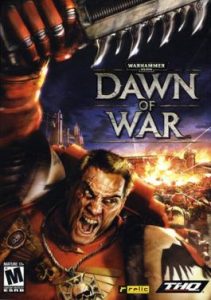726th played so far
Genre: Strategy
Platform: PC
Year of Release: 2004
Developer: Relic Entertainment
Publisher: THQ
When it comes to the universe, I’ve always been a fantasy player. There’s some interesting bits about the 40k universe, but nothing in it ever really tempted me. Sadly, until Total War: Warhammer, it hasn’t been greatly represented – even though many tried, and Shadows of the Horned Rat did work for me.
Similarly, while there were plenty of 40k games, Dawn of War is where it really took off and feels like it became massive. I still avoided it, but I’m now getting to the point where I really should give it a go and see whether it fits me.
Our Thoughts
It’s always a bit of a bad sign when one of the first levels of a game you play have you get stuck for a weird reason. In this case, it’s pathfinding: units got stuck between allies they were rescuing and couldn’t move out as they were now surrounded at all sides by those allies and had no way to get out. If the game had let me deal with individual units, it would have been fine, but since the whole squad couldn’t move in formation, it was stuck there.
Luckily, this didn’t repeat itself. Instead, I got to get into this game. Working with small squads made ordering them around more convenient. It feels like Warcraft 3, though without the strong presence of that game’s hero units. You have leaders, but they join squads and feel like they have less of an effect. As long as the pathfinding cooperates, it’s straight forward to control and grow, in a way that nicely replicates the 40k experience but makes it work better in the context of game building.
Base building is similarly simplified, with enough buildings to keep it interesting but not quite the mess you get in other RTS games. You mostly reinforce the squad so they don’t need to be near buildings and unit numbers aren’t too complex.
Resources are managed in a different way. You capture the strategic points that surround the area, which provide you with an income as you hold them as well as allowing for some defensive structures being built – mostly so nobody else takes over. It makes map control feel more real as you really have to reach and control areas and streamlines a lot of resource gathering.
Another way in which the game streamlines the experience is the way you handle reinforcements. You can always reinforce your squads where they are, meaning that during stealth and one man base less missions, you can make your way through more easily. That means that unless you’re fully wiped out, losses are a lot less crippling. It’s a nice mercy and improves the experience over what we’re used to from Red Alert.
There are only 11 story missions, all focused around the space marines, which means that my experience with the other armies was very limited. They’re decently chunky missions though, which makes up a bit for the shorter length, and they are varied enough to keep them interesting.
And it means I can see a lot of orcs flying through the air. That stays cool.
Final Thoughts
There’s probably a lot more to this game at a multiplayer level, but I had a great time playing the story missions. The structure is great and the whole experience is streamlined compared to the RTSes I’m used to, which makes it quicker to go through. It’s worth a revisit and I’m looking forward to playing the sequel.

[…] first Dawn of War game hit a strategy spot, focusing on smaller squads that are easier to follow and keep track of. […]